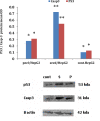Pomegranate Seeds and Peel Ethanolic Extracts Anticancer Potentials and Related Genetic, Histological, Immunohistochemical, Apoptotic and Oxidative Stress Profiles: In vitro Study
- PMID: 37090425
- PMCID: PMC10115208
- DOI: 10.2147/JEP.S404321
Pomegranate Seeds and Peel Ethanolic Extracts Anticancer Potentials and Related Genetic, Histological, Immunohistochemical, Apoptotic and Oxidative Stress Profiles: In vitro Study
Abstract
Introduction: Owing to their great quantity of hydrolyzable anthocyanins and tannins, the peel and seeds of pomegranate are edible and possess potent anti-oxidant and anti-inflammatory characteristics. This work aims to trace the pomegranate seed and peel ethanolic extracts' anticancer activity against liver cancer cell line, namely HepG2 and related histopathological, immunohistochemical, genetic and oxidative stress profile.
Methods: In vitro study for both seed and peel extract showed the prevalence of phenols, polyphenols and acids, those have anti-proliferative potential against liver cancer cell line (HepG2) with 50% inhibitory concentration (IC50) of seed significantly reduced that of peel. Toxicity of test extracts was concentration dependent and accompanied with cell cycle arrest and cell death at theG0/G1 and S phases but not at the G2/M phase. Cell arrest was supplemented with raised ROS, MDA and decreased SOD, GSH and Catalase.
Results and discussion: Apoptosis-related genes showed significant up-expression of pro-apoptotic gene (P53), Cy-C, Bax, and casp-3 and down expression of anti-apoptotic gene (Bcl-2). Also, Casp-3 and P53 proteins were substantially expressed under the effect of test extracts. Histopathological study demonstrated that the untreated cells (control group) were regular cells with nuclear pleomorphism and hyperchromatic nuclei, while seed and peel extracts-treated cells showed necrosis, mixed euchromatin and heterochromatin, intra-nuclear eosinophilic structures, burst cell membranes, and the shrunken apoptotic cells with nuclear membranes and irregular cells. Finally, PCNA gene detected by immunohistochemistry was down regulated significantly under the effect of seed extract treatment than in case of cell medication with peel extract.
Keywords: HepG2 cells; apoptosis; cell viability; immunohistochemistry; oxidative stress; pomegranate.
© 2023 Nasr et al.
Conflict of interest statement
The authors declare that they have no competing interests.
Figures







Similar articles
-
The Anti-Inflammatory, Anti-Apoptotic, and Antioxidant Effects of a Pomegranate-Peel Extract against Acrylamide-Induced Hepatotoxicity in Rats.Life (Basel). 2022 Jan 31;12(2):224. doi: 10.3390/life12020224. Life (Basel). 2022. PMID: 35207511 Free PMC article.
-
Nutritional and phytochemical profile of pomegranate ("Wonderful variety") peel and its effects on hepatic oxidative stress and metabolic alterations.J Food Biochem. 2022 Apr;46(4):e13913. doi: 10.1111/jfbc.13913. Epub 2021 Aug 28. J Food Biochem. 2022. PMID: 34453451
-
Chemical profiling, in vitro antimicrobial and antioxidant activities of pomegranate, orange and banana peel-extracts against pathogenic microorganisms.J Genet Eng Biotechnol. 2021 May 30;19(1):80. doi: 10.1186/s43141-021-00151-0. J Genet Eng Biotechnol. 2021. PMID: 34056675 Free PMC article.
-
Anticancer Effect of Pomegranate Peel Polyphenols against Cervical Cancer.Antioxidants (Basel). 2023 Jan 5;12(1):127. doi: 10.3390/antiox12010127. Antioxidants (Basel). 2023. PMID: 36670990 Free PMC article. Review.
-
Pomegranate and type 2 diabetes.Nutr Res. 2013 May;33(5):341-8. doi: 10.1016/j.nutres.2013.03.003. Epub 2013 Apr 15. Nutr Res. 2013. PMID: 23684435 Review.
Cited by
-
Pomegranate peel: Bioactivities as antimicrobial and cytotoxic agents.Food Sci Nutr. 2024 Mar 5;12(4):2818-2832. doi: 10.1002/fsn3.3963. eCollection 2024 Apr. Food Sci Nutr. 2024. PMID: 38628214 Free PMC article.
-
The Antiproliferative Activity of Adiantum pedatum Extract and/or Piceatannol in Phenylhydrazine-Induced Colon Cancer in Male Albino Rats: The miR-145 Expression of the PI-3K/Akt/p53 and Oct4/Sox2/Nanog Pathways.Molecules. 2023 Jul 20;28(14):5543. doi: 10.3390/molecules28145543. Molecules. 2023. PMID: 37513415 Free PMC article.
-
Exploring Punicalagin Potential Against Cancers: A Comprehensive Review.Food Sci Nutr. 2025 Feb 27;13(3):e70072. doi: 10.1002/fsn3.70072. eCollection 2025 Mar. Food Sci Nutr. 2025. PMID: 40018013 Free PMC article. Review.
-
Pomegranate seeds: a comprehensive review of traditional uses, chemical composition, and pharmacological properties.Front Pharmacol. 2024 Jul 11;15:1401826. doi: 10.3389/fphar.2024.1401826. eCollection 2024. Front Pharmacol. 2024. PMID: 39055489 Free PMC article. Review.
-
Laser Ablation-Generated Crystalline Selenium Nanoparticles Prevent Damage of DNA and Proteins Induced by Reactive Oxygen Species and Protect Mice against Injuries Caused by Radiation-Induced Oxidative Stress.Materials (Basel). 2023 Jul 22;16(14):5164. doi: 10.3390/ma16145164. Materials (Basel). 2023. PMID: 37512437 Free PMC article.
References
LinkOut - more resources
Full Text Sources
Research Materials
Miscellaneous

